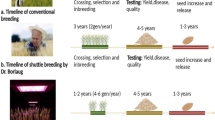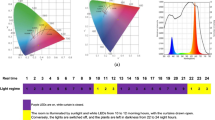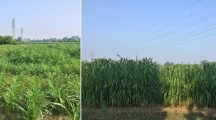Abstract
The development of hybrid broccoli genotypes with enhanced levels of 4-methylsulphinylbutyl glucosinolate, the precursor of anticarcinogenic isothiocyanate sulforaphane (SF), by introgressing genomic segments from the wild ancestor Brassica villosa is described. We demonstrate that to obtain enhanced levels of either 3-methylsulphinylpropyl or 4-methylsulphinylbutyl glucosinolate it is necessary to have B. villosa alleles in either a homozygous or heterozygous state at a single quantitative trait locus (QTL) on O2. The ratio of these two glucosinolates, and thus whether iberin or SF is generated upon hydrolysis, is determined by the presence or absence of B. villosa alleles at this QTL, but also at an additional QTL2 on O5. We further demonstrate that following mild cooking high glucosinolate broccoli lines generate about three fold higher levels of SF than conventional varieties. Commercial freezing processes and storage of high glucosinolate broccoli maintains the high level of glucosinolates compared to standard cultivars, although the blanching process denatures the endogenous myrosinase activity.
Article PDF
Similar content being viewed by others
Avoid common mistakes on your manuscript.
References
Abercrombie JM, Farnham MW, Rushing JW (2005) Genetic combining ability of glucoraphanin level and other horticultural traits of broccoli. Euphytica 143:145–151
Bennett R, Mellon FA, Rosa E, Perkins L, Kroon PA (2004) Profiling glucosinolates, flavonoids, alkaloids and other secondary metabolites in tissues of Azima tetracantha L. (Salvadoraceae). J Agri Food Chem (in press)
Bonnesen C, Eggleston IM, Hayes JD (2001) Dietary indoles and isothiocyanates that are generated from cruciferous vegetables can both stimulate apoptosis and confer protection against DNA damage in human colon cell lines. Cancer Res 61:6120–6130
Chen YR, Wang W, Kong AN, Tan TH (1998) Molecular mechanisms of c-Jun N-terminal kinase-mediated apoptosis induced by anticarcinogenic isothiocyanates. J Biol Chem 273:1769–1775
Chiao JW, Chung FL, Kancherla R, Ahmed T, Mittelman A, Conaway CC (2002) Sulforaphane and its metabolite mediate growth arrest and apoptosis in human prostate cancer cells. Int J Oncol 20:631–636
Conaway CC, Getahun SM, Liebes LL, Pusateri DJ, Topham DK, Botero-Omary M, Chung FL (2000) Disposition of glucosinolates and sulforaphane in humans after ingestion of steamed and fresh broccoli. Nutr Cancer 38:168–178
de Quiros HC, Magrath R, McCallum D, Kroymann J, Scnabelrauch D, Mitchell-Olds T, Mithen R (2000) alpha-keto acid elongation and glucosinolate biosynthesis in Arabidopsis thaliana. Theor Appl Genet 101:429–437
Dinkova-Kostova AT, Holtzclaw WD, Cole RN, Itoh K, Wakabayashi N, Katoh Y, Yamamoto M, Talalay P (2002) Direct evidence that sulfhydryl groups of keap1 are the sensors regulating induction of phase 2␣enzymes that protect against carcinogens and oxidants. Proc Natl Acad Sci USA 99:11908–11913
Farnham MW, Stephenson KK, Fahey JW (2005) Glucoraphanin level in broccoli seed is largely determined by genotype. Hortscience 40:50–53
Farnham MW, Wilson PE, Stephenson KK, Fahey JW (2004) Genetic and environmental effects on glucosinolate content and chemoprotective potency of broccoli. Plant Breed 123:60–65
Faulkner K, Mithen R, Williamson G (1998) Selective increase of the potential anticarcinogen 4- methylsulphinylbutyl glucosinolate in broccoli. Carcinogenesis 19:605–609
Fimognari C, Nusse M, Berti F, Iori R, Cantelli-Forti G, Hrelia P (2002a) Cyclin D3 and p53 mediate sulforaphane-induced cell cycle delay and apoptosis in non-transformed human T lymphocytes. Cell Mol Life Sci 59:2004–2012
Fimognari C, Nusse M, Cesari R, Iori R, Cantelli-Forti G, Hrelia P (2002b) Growth inhibition, cell-cycle arrest and apoptosis in human T-cell leukemia by the isothiocyanate sulforaphane. Carcinogenesis 23:581–586
Finley JW (2005) Proposed criteria for assessing the efficacy of cancer reduction by plant foods enriched in carotenoids, glucosinolates, polyphenols and selenocompounds. Ann Bot (Lond) 95:1075–1096
Foo HL, Gronning LM, Goodenough L, Bones AM, Danielsen BE, Whiting DA, Rossiter JT (2000) Purification and characterisation of epithiospecifier protein from Brassica napus: enzymic intramolecular sulphur addition within alkenyl thiohydroximates derived from alkenyl glucosinolate hydrolysis. FEBS Lett 468:243–246
Gamet-Payrastre L, Li P, Lumeau S, Cassar G, Dupont MA, Chevolleau S, Gasc N, Tulliez J, Terce F (2000) Sulforaphane, a naturally occurring isothiocyanate, induces cell cycle arrest and apoptosis in HT29 human colon cancer cells. Cancer Res 60:1426–1433
Getahun SM, Chung FL (1999) Conversion of glucosinolates to isothiocyanates in humans after ingestion of cooked watercress. Cancer Epidemiol Biomarkers Prev 8:447–451 http://www.ukcrop.net/perl/ace/pic/BrassicaDB?name=N15_BBSRC-SSR&class=Map)
Hu R, Kim BR, Chen C, Hebbar V, Kong AN (2003) The roles of JNK and apoptotic signaling pathways in PEITC-mediated responses in human HT-29 colon adenocarcinoma cells. Carcinogenesis 24:1361–1367
Jackson SJ, Singletary KW (2003) Sulforaphane: a naturally occurring mammary carcinoma mitotic inhibitor which disrupts tubulin polymerization. Carcinogenesis
Jeffery EH, Brown AF, Kurilich AC, Keck AS, Matusheski N, Klein BP, Juvik JA (2003) Variation in content of bioactive components in broccoli. J Food Compost Anal 16:323–330
Joseph MA, Moysich KB, Freudenheim JL, Shields PG, Bowman ED, Zhang Y, Marshall JR, Ambrosone CB (2004) Cruciferous vegetables, genetic polymorphisms in glutathione s-transferases m1 and t1, and prostate cancer risk. Nutr Cancer 50:206–213
Kim BR, Hu R, Keum YS, Hebbar V, Shen G, Nair SS, Kong AN (2003) Effects of glutathione on antioxidant response element-mediated gene expression and apoptosis elicited by sulforaphane. Cancer Res 63:7520–7525
Kore AM, Jeffery EH, Wallig MA (1993) Effects of 1-isothiocyanato-3-(methylsulfinyl)-propane on xenobiotic metabolizing enzymes in rats. Food Chem Toxicol 31:723–9
Lambrix V, Reichelt M, Mitchell-Olds T, Kliebenstein DJ, Gershenzon J (2001) The Arabidopsis epithiospecifier protein promotes the hydrolysis of glucosinolates to nitriles and influences Trichoplusia ni herbivory. Plant Cell 13:2793–2807
Lin HJ, Probst-Hensch NM, Louie AD, Kau IH, Witte JS, Ingles SA, Frankl HD, Lee ER, Haile RW (1998) Glutathione transferase null genotype, broccoli, and lower prevalence of colorectal adenomas. Cancer Epidemiol Biomarkers Prev 7:647–652
Lowe AJ, Moule C, Trick M, Edwards KJ (2004) Efficient large-scale development of microsatellites for marker and mapping applications in Brassica crop species. Theor Appl Genet 108:1103–1112
Magrath R, Bano F, Morgner M, Parkin I, Sharpe A, Lister C, Dean C, Turner J, Lydiate D, Mithen R (1994) Genetics of aliphatic glucosinolates.1. side-chain elongation in Brassica napus and Arabidopsis thaliana. Heredity 72:290–299
Matusheski NV, Juvik JA, Jeffery EH (2004) Heating decreases epithiospecifier protein activity and increases sulforaphane formation in broccoli. Phytochemistry 65:1273–1281
Mithen R, Faulkner K, Magrath R, Rose P, Williamson G, Marquez J (2003) Development of isothiocyanate-enriched broccoli, and its enhanced ability to induce phase 2 detoxification enzymes in mammalian cells. Theor Appl Genet 106:727–734
Munday R, Munday CM (2004) Induction of phase II detoxification enzymes in rats by plant-derived isothiocyanates: comparison of allyl isothiocyanate with sulforaphane and related compounds. J Agric Food Chem 52:1867–1871
Nachshon-Kedmi M, Fares FA, Yannai S (2004) Therapeutic activity of 3,3′-diindolylmethane on prostate cancer in an in vivo model. Prostate 61:153–160
Spitz MR, Duphorne CM, Detry MA, Pillow PC, Amos CI, Lei L, de Andrade M, Gu XJ, Hong WK, Wu XF (2000) Dietary intake of isothiocyanates: evidence of a joint effect with glutathione S-transferase polymorphisms in lung cancer risk. Cancer Epidemiol Biomarkers Prev 9:1017–1020
Wang L, Liu D, Ahmed T, Chung FL, Conaway C, Chiao JW (2004) Targeting cell cycle machinery as a molecular mechanism of sulforaphane in prostate cancer prevention. Int J Oncol 24:187–192
Wang W, Wang S, Howie AF, Beckett GJ, Mithen R, Bao Y (2005) Sulforaphane, erucin, and iberin up-regulate thioredoxin reductase 1 expression in human MCF-7 cells. J Agric Food Chem 53:1417–1421
Acknowledgements
We thank the staff at the University of Nottingham for help with field work. We also thank Sarah Pettitt, Food and Consumer Division, Christian Salvesen, for processing the frozen broccoli, Martyn Watling and his staff for assistance with the broccoli cultivation at ADAS Terrington, and Martin Brittain and his staff for assistance with broccoli cultivation and harvesting near Boston, UK. Funding was provided by the University of Nottingham, Seminis Inc and the Biotechnology and Biological Sciences Research Council.
Author information
Authors and Affiliations
Corresponding author
Rights and permissions
Open Access This is an open access article distributed under the terms of the Creative Commons Attribution Noncommercial License ( https://creativecommons.org/licenses/by-nc/2.0 ), which permits any noncommercial use, distribution, and reproduction in any medium, provided the original author(s) and source are credited.
About this article
Cite this article
Sarikamis, G., Marquez, J., Maccormack, R. et al. High glucosinolate broccoli: a delivery system for sulforaphane. Mol Breeding 18, 219–228 (2006). https://doi.org/10.1007/s11032-006-9029-y
Received:
Accepted:
Published:
Issue Date:
DOI: https://doi.org/10.1007/s11032-006-9029-y




